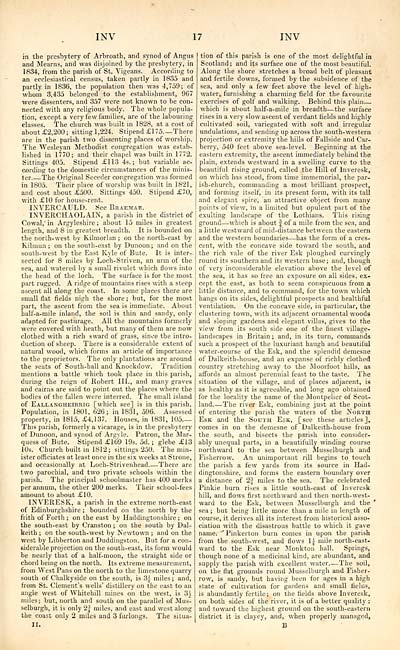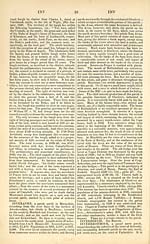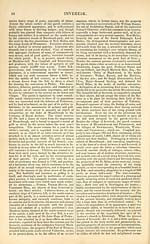Download files
Complete book:
Individual page:
Thumbnail gallery: Grid view | List view

INV
17
INV
in the presbytery of Arbroath, and synod of Angus
and Mearns, and was disjoined by the presbytery, in
1834, from the parish of St, Vigeans. According to
an ecclesiastical census, taken partly in 1835 and
partly in 1836, the population then was -1,759; of
whom 3,435 belonged to the establishment, 967
were dissenters, and 357 were not known to be con-
nected with any religious body. The whole popula-
tion, except a very few families, are of the labouring
classes. The church was built in 1828, at a cost of
about£2,200; sitting 1,-224; Stipend£175 There
are in the parish two dissenting places of worship.
The Wesleyan Methodist congregation was estab-
lished in 1770; and their chapel was built in 1772.
Sittings 405. Stipend £113 4s.; but variable ac-
cording to the domestic circumstances of the minis-
ter.. — The Original Seceder congregation was formed
in 1805. Their place of worship was built in 1821,
and cost about £500. Sittings 450. Stipend £70,
with £10 for house-rent.
INVERCAULD. See Braehiar.
INVERCHAOLAIN, a parish in the district of
Cowal,' in Argyleshire ; about 15 miles in greatest
length, and 8 in greatest breadth. It is bounded on
the north-west by Kilmorlan ; on the north-east by
Kilinun ; on the south-east by Dunoon; and on the
south-west by the East Kyle of Bute. It is inter-
sected for 8 miles by Loch-Striven, an arm of the
sea, and watered by a small rivulet which flows into
the head of the loch. The surface is for the most
part rugged. A ridge of mountains rises with a steep
ascent all along the coast. In some places there are
small flat fields nigh the shore ; but, for the most
part, the ascent from the sea is immediate. About
balf-a-mile inland, the soil is thin and sandy, only
adapted for pasturage. All the mountains formerly
were covered with heath, but many of them are now
clothed with a rich sward of grass, since the intro-
duction of sheep. There is a considerable extent of
natural wood, which forms an article of importance
to the proprietors. The only plantations are around
the seats of South-hall and Knockdow. Tradition
mentions a battle which took place in this parish,
during the reign of Robert III., and many graves
and cairns are said to point out the places where the
bodies of the fallen were interred. The small island
of Eallancheirrig [which see] is in this parish.
Population, in 1801, 626; in 1831, 596. Assessed
property, in 1815, £4,137. Houses, in 1831, 105.—
This parish, formerly a vicarage, is in the presbytery
of Dunoon, and synod of Argvle. Patron, the Mar-
quess of Bute. Stipend £169 19s. 5d. ; glebe £13
10s. Church built in 1812; sittings 250. The min-
ister officiates at least once in the six weeks at Strone,
and occasionally at Loch-Strivenhead There are
two parochial, and two private schools within the
parish. The principal schoolmaster has 400 merks
per annum, the other 200 merks. Their school-fees
amount to about £10.
INVERESK, a parish in the extreme north-east
of Edinburghshire ; bounded on the north by the
frith of Forth ; on the east by Haddingtonshire ; on
the south-east by Cranston ; on the south by Dal-
keith ; on the south-west by Newtown ; and on the
west by Libberton and Duddingston. But for a con-
siderable projection on the south-east, its form would
be nearly that of a half-moon, the straight side or
chord being on the north. Its extreme measurement,
from West Pans on the north to the limestone quarry
south of Chalkyside on the south, is 3.t miles ; and,
from St. Clement's wells' distillery on the east to an
angle west of Whitehill mines on the west, is 3i
miles; but, north and south on the parallel of Mus-
selburgh, it is only 2| miles, and east and west along
the coast only 2 miles and 3 furlongs. The situa-
II.
tion of this parish is one of the most delightful in
Scotland; and its surface one of the most beautiful.
Along the shore stretches a broad belt of pleasant
and fertile downs, formed by the subsidence of the
sea, and only a few feet above the level of high-
water, furnishing a charming field for the favourite
exercises of golf and walking. Behind this plain —
which is about half-a-mile in breadth — the surface
rises in a very slow ascent of verdant fields and highly
cultivated soil, variegated with soft and irregular
undulations, and sending up across the south-western
projection or extremity the hills of Fallside and Car-
berry, 540 feet above sea-level. Beginning at the
eastern extremity, the ascent immediately behind the
plain, extends westward in a swelling curve to the
beautiful rising ground, called the Hill of lnveresk,
on which has stood, from time immemorial, the par-
ish-church, commanding a most brilliant prospect,
and forming itself, in its present form, with its tall
and elegant spire, an attractive object from many
points of view, in a limited but opulent part of the
exulting landscape of the Lothians. This rising
ground — which is about } of a mile from the sea, and
a little westward of mid-distance between the eastern
and the western boundaries — has the form of a cres-
cent, with the concave side toward the south, and
the rich vale of the river Esk ploughed curvingly
round its southern and its western base; and, though,
of very inconsiderable elevation above the level of
the sea, it has so free an exposure on all sides, ex-
cept the east, as both to seem conspicuous from a
little distance, and to command, for the town which
hangs on its sides, delightful prospects and healthful
ventilation. On the concave side, in particular, the
clustering town, with its adjacent ornamental woods
and sloping gardens and elegant villas, gives to the
view from its south side one of the finest village-
landscapes in Britain ; and, in its turn, commands
such a prospect of the luxuriant haugh and beautiful
water-course of the Esk, and the splendid demesne
of Dalkeith-house, and an expanse of richly clothed
country stretching away to the Moorfoot hills, as
affords an almost perennial feast to the taste. The
situation of the village, and of places adjacent, is
as healthy as it is agreeable, and long ago obtained
for the locality the name of the Montpelier of Scot-
land The river Esk, combining just at the point
of entering the parish the waters of the North
Esk and the South Esk, [see these articles],
comes in on the demesne of Dalkeith-house from
the south, and bisects the parish into consider-
ably unequal parts, in a beautifully winding course
northward to the sea between Musselburgh and
Fisherrow. An unimportant rill begins to touch
the parish a few yards from its source in Had-
dingtonshire, and forms the eastern boundary over
a distance of 23 miles to the sea. The celebrated
Pinkie burn rises a little south-east of lnveresk
hill, and flows first northward and then north-west-
ward to the Esk, between Musselburgh and the *
sea ; but being little more than a mile in length of
course, it derives all its interest from historical asso-
ciation with the disastrous battle to which it gave
name. "Pinkerton burn comes in upon the parish
from the south-west, and flows li mile north-east-
ward to the Esk near Monkton hall. Springs,
though none of a medicinal kind, are abundant, and
supply the parish with excellent water. — The soil,
on the flat grounds round Musselburgh and Fisher-
row, is sandy, but having been for ages in a high
state of cultivation for gardens and small fielus,
is abundantly fertile; on the fields above lnveresk,
on both sides of the river, it is of a better quality ;
and toward the highest ground on the south-eastern
district it is clayey, and, when properly managed,
17
INV
in the presbytery of Arbroath, and synod of Angus
and Mearns, and was disjoined by the presbytery, in
1834, from the parish of St, Vigeans. According to
an ecclesiastical census, taken partly in 1835 and
partly in 1836, the population then was -1,759; of
whom 3,435 belonged to the establishment, 967
were dissenters, and 357 were not known to be con-
nected with any religious body. The whole popula-
tion, except a very few families, are of the labouring
classes. The church was built in 1828, at a cost of
about£2,200; sitting 1,-224; Stipend£175 There
are in the parish two dissenting places of worship.
The Wesleyan Methodist congregation was estab-
lished in 1770; and their chapel was built in 1772.
Sittings 405. Stipend £113 4s.; but variable ac-
cording to the domestic circumstances of the minis-
ter.. — The Original Seceder congregation was formed
in 1805. Their place of worship was built in 1821,
and cost about £500. Sittings 450. Stipend £70,
with £10 for house-rent.
INVERCAULD. See Braehiar.
INVERCHAOLAIN, a parish in the district of
Cowal,' in Argyleshire ; about 15 miles in greatest
length, and 8 in greatest breadth. It is bounded on
the north-west by Kilmorlan ; on the north-east by
Kilinun ; on the south-east by Dunoon; and on the
south-west by the East Kyle of Bute. It is inter-
sected for 8 miles by Loch-Striven, an arm of the
sea, and watered by a small rivulet which flows into
the head of the loch. The surface is for the most
part rugged. A ridge of mountains rises with a steep
ascent all along the coast. In some places there are
small flat fields nigh the shore ; but, for the most
part, the ascent from the sea is immediate. About
balf-a-mile inland, the soil is thin and sandy, only
adapted for pasturage. All the mountains formerly
were covered with heath, but many of them are now
clothed with a rich sward of grass, since the intro-
duction of sheep. There is a considerable extent of
natural wood, which forms an article of importance
to the proprietors. The only plantations are around
the seats of South-hall and Knockdow. Tradition
mentions a battle which took place in this parish,
during the reign of Robert III., and many graves
and cairns are said to point out the places where the
bodies of the fallen were interred. The small island
of Eallancheirrig [which see] is in this parish.
Population, in 1801, 626; in 1831, 596. Assessed
property, in 1815, £4,137. Houses, in 1831, 105.—
This parish, formerly a vicarage, is in the presbytery
of Dunoon, and synod of Argvle. Patron, the Mar-
quess of Bute. Stipend £169 19s. 5d. ; glebe £13
10s. Church built in 1812; sittings 250. The min-
ister officiates at least once in the six weeks at Strone,
and occasionally at Loch-Strivenhead There are
two parochial, and two private schools within the
parish. The principal schoolmaster has 400 merks
per annum, the other 200 merks. Their school-fees
amount to about £10.
INVERESK, a parish in the extreme north-east
of Edinburghshire ; bounded on the north by the
frith of Forth ; on the east by Haddingtonshire ; on
the south-east by Cranston ; on the south by Dal-
keith ; on the south-west by Newtown ; and on the
west by Libberton and Duddingston. But for a con-
siderable projection on the south-east, its form would
be nearly that of a half-moon, the straight side or
chord being on the north. Its extreme measurement,
from West Pans on the north to the limestone quarry
south of Chalkyside on the south, is 3.t miles ; and,
from St. Clement's wells' distillery on the east to an
angle west of Whitehill mines on the west, is 3i
miles; but, north and south on the parallel of Mus-
selburgh, it is only 2| miles, and east and west along
the coast only 2 miles and 3 furlongs. The situa-
II.
tion of this parish is one of the most delightful in
Scotland; and its surface one of the most beautiful.
Along the shore stretches a broad belt of pleasant
and fertile downs, formed by the subsidence of the
sea, and only a few feet above the level of high-
water, furnishing a charming field for the favourite
exercises of golf and walking. Behind this plain —
which is about half-a-mile in breadth — the surface
rises in a very slow ascent of verdant fields and highly
cultivated soil, variegated with soft and irregular
undulations, and sending up across the south-western
projection or extremity the hills of Fallside and Car-
berry, 540 feet above sea-level. Beginning at the
eastern extremity, the ascent immediately behind the
plain, extends westward in a swelling curve to the
beautiful rising ground, called the Hill of lnveresk,
on which has stood, from time immemorial, the par-
ish-church, commanding a most brilliant prospect,
and forming itself, in its present form, with its tall
and elegant spire, an attractive object from many
points of view, in a limited but opulent part of the
exulting landscape of the Lothians. This rising
ground — which is about } of a mile from the sea, and
a little westward of mid-distance between the eastern
and the western boundaries — has the form of a cres-
cent, with the concave side toward the south, and
the rich vale of the river Esk ploughed curvingly
round its southern and its western base; and, though,
of very inconsiderable elevation above the level of
the sea, it has so free an exposure on all sides, ex-
cept the east, as both to seem conspicuous from a
little distance, and to command, for the town which
hangs on its sides, delightful prospects and healthful
ventilation. On the concave side, in particular, the
clustering town, with its adjacent ornamental woods
and sloping gardens and elegant villas, gives to the
view from its south side one of the finest village-
landscapes in Britain ; and, in its turn, commands
such a prospect of the luxuriant haugh and beautiful
water-course of the Esk, and the splendid demesne
of Dalkeith-house, and an expanse of richly clothed
country stretching away to the Moorfoot hills, as
affords an almost perennial feast to the taste. The
situation of the village, and of places adjacent, is
as healthy as it is agreeable, and long ago obtained
for the locality the name of the Montpelier of Scot-
land The river Esk, combining just at the point
of entering the parish the waters of the North
Esk and the South Esk, [see these articles],
comes in on the demesne of Dalkeith-house from
the south, and bisects the parish into consider-
ably unequal parts, in a beautifully winding course
northward to the sea between Musselburgh and
Fisherrow. An unimportant rill begins to touch
the parish a few yards from its source in Had-
dingtonshire, and forms the eastern boundary over
a distance of 23 miles to the sea. The celebrated
Pinkie burn rises a little south-east of lnveresk
hill, and flows first northward and then north-west-
ward to the Esk, between Musselburgh and the *
sea ; but being little more than a mile in length of
course, it derives all its interest from historical asso-
ciation with the disastrous battle to which it gave
name. "Pinkerton burn comes in upon the parish
from the south-west, and flows li mile north-east-
ward to the Esk near Monkton hall. Springs,
though none of a medicinal kind, are abundant, and
supply the parish with excellent water. — The soil,
on the flat grounds round Musselburgh and Fisher-
row, is sandy, but having been for ages in a high
state of cultivation for gardens and small fielus,
is abundantly fertile; on the fields above lnveresk,
on both sides of the river, it is of a better quality ;
and toward the highest ground on the south-eastern
district it is clayey, and, when properly managed,
Set display mode to: Large image | Transcription
Images and transcriptions on this page, including medium image downloads, may be used under the Creative Commons Attribution 4.0 International Licence unless otherwise stated. ![]()
| Gazetteers of Scotland, 1803-1901 > Topographical, statistical, and historical gazetteer of Scotland > Volume 2 > (27) Page 17 |
|---|
| Permanent URL | https://digital.nls.uk/97448914 |
|---|
| Description | Volume second: I-Z. |
|---|---|
| Shelfmark | Map Room Ref.2 |
| Attribution and copyright: |
|

